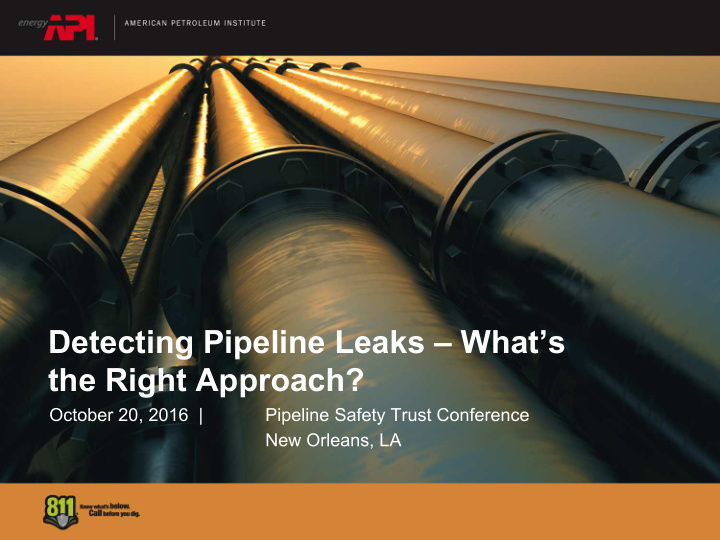



Detecting Pipeline Leaks – What’s the Right Approach? October 20, 2016 | Pipeline Safety Trust Conference New Orleans, LA
Leak Detection § Best Defense is Preventing Leaks from Occurring in First Place – Proactive pipeline integrity and damage prevention programs § Leak Detection – Focuses on how to detect promptly to minimize size and consequence – One approach does not fit all – Various pipeline systems and operating conditions call for different approaches
Detecting Leaks – One approach does not fit all § Ruptures – quicker detection – Pressure & Flow deviation alarms – Computational pipeline monitoring (CPM) § Seepers – slower detection – Visual surveillance – air and ground – Facility gas monitoring & thermal imaging – Line balancing & tightness tests § Everything In-Between – Computational pipeline monitoring (CPM) – Pressure wave & statistical patterns – Fiber optic cable technology research through PRCI using acoustic & thermal sensing Complicating Factors – Compressibility of various fuels – Elevation differences & changing pressure patterns – Pipeline size and operating pressure
Typical Liquid Pipeline Leak Detection Using CPM in Flowing Conditions 25% Short-term leak detection driven by instrument accuracy, type of CPM used, line pressures, and Leak Size as a Percentage of Flow Rate 20% communication speed and reliability Industry is striving to detect smaller leaks, 15% more quickly, and more reliably Longer-term leak detection limited 10% by equipment capabilities. More industry work is needed 5% 0% 0 3 6 9 12 Time to Detect Leak (hr) Typical CPM Performance Typical RTTM Performance Technology + Human Factors
Effective LD is More than Great Technology § Technology Needs Strong § Control Center Operations Need Control Center Operations Strong Technology 1. Recognizing abnormal 1. Normal dynamic operating conditions is not always obvious conditions cause pressure/flow changes 2. Slack line conditions due to starts 2. “Think Leak” safety culture and stops 3. High false alarm rates cause fatigue 3. Focusing on continuous and distraction improvement using risk-based priorities Pipeline Operators need effective LD Program Management – API RP 1175
API RP 1175 Leak Detection Program Management § Identifies all detection methods, policies, processes, and human element. § December 2015 - Published RP 1175 – Culture & Strategy – Selection of Leak Detection Methods – Performance Targets & Metrics – Procedures, Training, Maintenance – Alarm Management & Testing – Managing Changes § 2016 – Formed Implementation Team – Hosting Webinars – Workshop planned at 2017 API Pipeline Conference – Developing training and assessment tools
Keys to Success 1. Have a Continuous Improvement Mindset regarding People, Procedures, & Technology – RP 1173 Safety Management Systems – RP 1175 Leak Detection Program Management 2. Have a “Think Leak” Safety-First Culture – Leadership support – Training and operating discipline 3. Have a collaborative and proactive approach – Industry engagement to share best practices, lessons learned, and technology research (PRCI) Shared Mission: Provide reliable energy supply to meet our society’s needs in the safest & environmentally responsible manner possible.
Recommend
More recommend